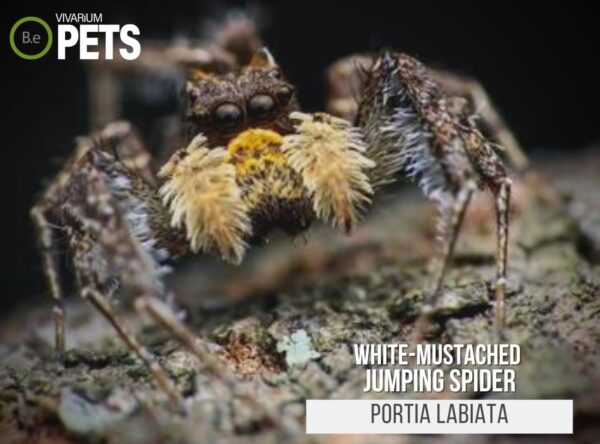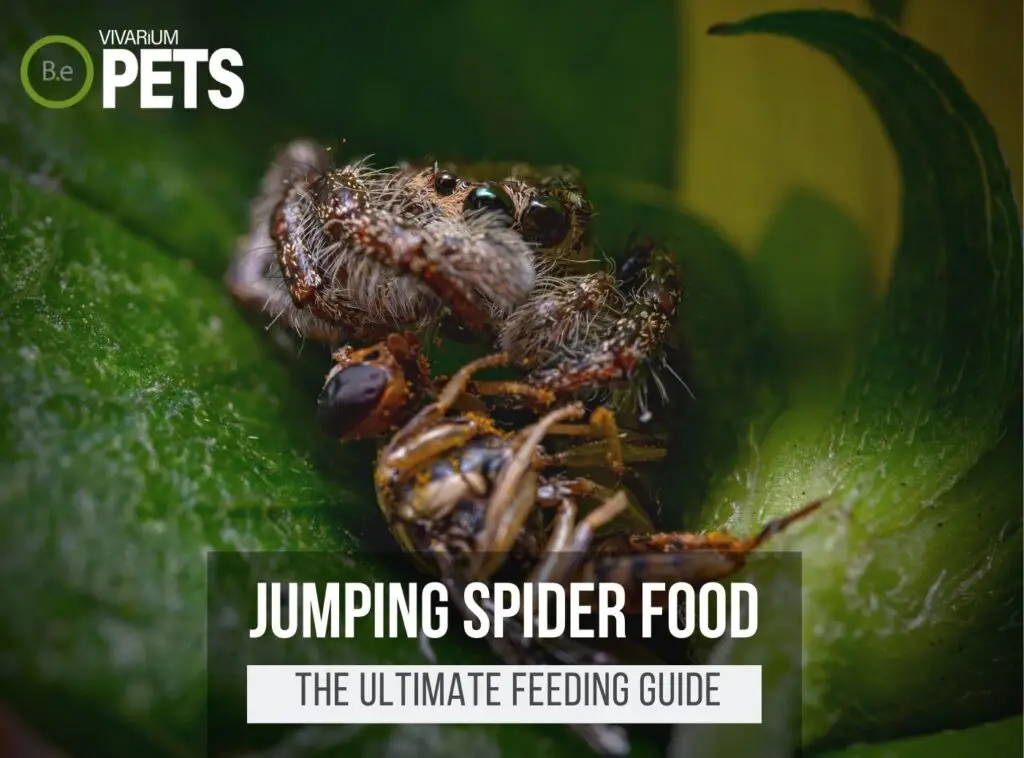Welcome to your guide to the White-Mustached Jumping Spider (Portia labiata)!
As the name implies, this type of pet jumping spider has a distinctive white mustache on its face and is known to exhibit exceptional jumping capabilities.
In addition to understanding the physical characteristics and where to find these spiders, you’ll also learn about how to capture, provide proper care and housing, and even breed them.
Let’s get started!
Table Of Contents:
ToggleWhat Are White-Mustached Jumping Spiders?
Portia labiata, commonly known as the White-Mustached Jumping Spider, is a species of spider belonging to the family Salticidae.
It has a muscular body with distinctive white hairs below its eyes which led to its common name.
It lives in tropical or subtropical regions such as Australia, parts of Asia, Central, and South America and has also been found in some parts of North America, although it is not native to that region.
It is an active hunter and is known to move quickly and exhibit impressive jumping capabilities, making it a popular subject of study for entomologists.
Create the perfect home for your arachnid with our Customizable Spider Enclosure Kits, designed to meet all their habitat needs.
What Do White-Mustached Jumping Spiders Look Like?
Portia labiata can reach sizes of 1 centimeter in body length, making them quite small and lightweight.
The adult spider’s body is generally a reddish-brown color with light patches. In addition to the mustache, they have a distinctive set of black stripes on their abdomen.
They have eight eyes, two of which are highly sensitive and help them detect movement.
Benefits Of Using White-Mustached Jumping Spiders
Portia labiata is more than suitable for life in a vivarium!
This species is known to be quite hardy and easy to care for, making them perfect for both novice and experienced hobbyists.
They are also comparably small when compared to most vivarium pets, but they are full of personality and fascinating to watch.
They can even keep the environment clean since they are natural predators and can help control insect populations.
The White-Mustached Jumping Spider is also less aggressive compared to other spiders, so it can easily cohabitate with other species in an enclosure.

Portia labiata Facts
The White-Mustached Jumper is a diurnal hunting spider with an average lifespan of a few years.
In the wild, they feed on small insects, such as flies and ants, and have a generally shy, calm temperament.
Breeding typically involves the male performing an elaborate courtship ritual for the female, after which she will lay anywhere from a few to several hundred eggs.
Habitat
Portia labiata is native to Southeastern Asia and commonly found in India, the Philippines, and Indonesia.
In ideal conditions, the White-Mustached Jumping Spider can be found anywhere from the forest floor to the canopy of the rainforest.
The spider prefers humid, warm areas that it can hide in, such as leaf litter, tree logs, and bark, or around rock formations.
Replicate their natural habitat perfectly with our bioactive species-specific soil mixes, designed to provide the ideal moisture and organic content for your arachnids.
Diet
Portia labiata is mostly insectivorous, known to feed on a variety of small insects like mites, beetles, and flies.
They have also been observed to eat other spiders, including other members of the Portia genus.
In the wild, these spiders are also known to forage for food on other creatures, such as millipedes, scorpions, and even small lizards.
They will also scavenge for food by stealing prey that other spiders have caught or killed.
Finally, they are also reported to eat some plant material, perhaps as a means of obtaining vitamins and minerals they may not get in other parts of their diet.
Temperament
The White-Mustached Jumping Spider is a naturally curious creature that is not particularly hostile toward humans.
It can be quite friendly when handled carefully and has even been known to sit calmly on a human’s hand.
This spider also displays an interesting level of intelligence, as it is capable of learning quickly and can even recognize certain approaches that it has encountered before.
When it comes to other animals, Portia labiata usually displays an inquisitive attitude and is not typically aggressive.
It favors smaller prey, such as insects, and will typically try to avoid larger animals, including other spiders.
Lifespan
The average lifespan of a White-Mustached Jumping Spider is approximately 1-2 years.
Depending on environmental factors, they can live up to 3 years.
Throughout their lifespan, they go through several life stages. They begin as eggs that are then hatched into juveniles.
As the spider develops, it grows and molts several times, eventually reaching adulthood.
During the adult stage, they reach sexual maturity and are ready to reproduce.
Breeding
Portia labiata mate by way of courtship rituals, where the male will perform a highly elaborate dance to attract the female’s attention.
Females are usually reluctant to mate, so the male has to dance and vibrate with increasing intensity to convince her.
After mating, the female will lay her eggs in an area she feels is safe.
Typically, she will take several days to construct a sac of silk to encapsulate the eggs.
This sac is then attached to a secure surface and can produce up to hundreds of eggs in a single batch.
With the proper care and nutrition, the eggs will hatch in around four weeks, producing hundreds of tiny replicas of the parent spiders.
Where To Find White-Mustached Jumping Spiders
Finding Portia labiata in the wild can be a difficult task as these spiders are often found in camouflaged positions in their habitats.
When searching for them, you should keep an eye out for trees, rocks, and other objects they may hide under or around.
They have also been known to inhabit the sides of existing structures and buildings in more urban areas such as warehouses or parking lots.
For those looking to buy or adopt White-Mustached Jumping Spiders, the best bet is to reach out to hobbyists who specialize in spiders and arachnids.
There are many reputable breeders of common and rare jumping spiders who can provide you with healthy and well-cared-for individuals for sale.
It can also be helpful to join an online community or forum of spider hobbyists to ask any questions you might have to get answers from experienced people.
Portia labiata Care
Caring for Portia labiata requires providing adequate heating and humidity levels, a suitable home, and the right type of food.
It is important to handle them carefully and watch out for common problems.
You can also breed these spiders if you have the right enclosure setup.
Tank Requirements
The ideal vivarium type for the White-Mustached Jumping Spider should be a spacious terrarium with a secure lid, ideally at least 5 gallons in size.
A tank with a humidity range between 70%-80% is best for them, and the ideal temperature should be between 71-80°F.
The pH of the water given should stay between 5-8, and the water should not be too hard or too soft (a hardness between 3-8 dH is preferred).
As for the terrarium substrate, coconut husks, dried leaves, and peat moss mixed make for a great base for these spiders.
Finally, for terrarium lighting, low-wattage bulbs can provide natural basking light, but these spiders should not be exposed to direct sunlight.
What Do Portia labiata Eat?
Feeding Portia labiata is an essential part of successful care since proper nutrition ensures your spider’s health and longevity.
A good rule of thumb is to feed your spider once a week to every two weeks.
Here is a list of things you can feed them:
- Cockroaches
- Crickets
- Mealworms
- Waxworms
- Fruit flies
- Small pieces of fish
If you can, try to vary the food to provide them with an appropriate diet.
Also, try to choose prey that is roughly the same size as the spider’s body.
When they’re done eating, again, remove any uneaten food to keep the enclosure clean.
If you’re looking for a more detailed approach to feeding these critters, be sure to check out my ultimate DIY jumping spider food guide. I give a more in-depth explanation of the best foods and my favorite recipe.
Best Tankmates For White-Mustached Jumping Spiders
It can be beneficial to keep Portia labiata with other calming tankmates.
Keeping a few more of the same species will help create socialization and keep them happy.
Other arthropods like non-predatory mites or small non-aggressive critters, such as springtails and red wrigglers, are good tank mates for White-Mustached Jumping Spiders and can provide some natural pest control and additional nutrients for the spider.
It’s important to research any potential tankmates ahead of time to ensure that they can safely and peacefully coexist, and to be aware of any risk of predation.
Conclusion
Congratulations! You now have a better understanding of the White Mustached Jumping Spider and the necessary steps to care for one.
To summarize, provide appropriate housing and a suitable environment, feed your spider appropriately, observe them, and contact experts if necessary.
We hope this Portia labiata guide has been useful and that you enjoy your tiny friend!
Create the ideal habitat for your arachnids with our species-specific soil mixes and Spider Enclosure Kits. These products provide everything you need for a thriving spider habitat.
Frequently Asked Questions
The Portia jumping spider (Portia labiata) is a species of spider known for its impressive intelligence.
It is able to use problem–solving skills to identify, stalk, and capture prey.
It has shown an ability to recognize patterns, remember the solutions that it has used previously, and learn the behaviors of other spider species.
It also has excellent vision and jumping abilities, making it an agile hunter.







